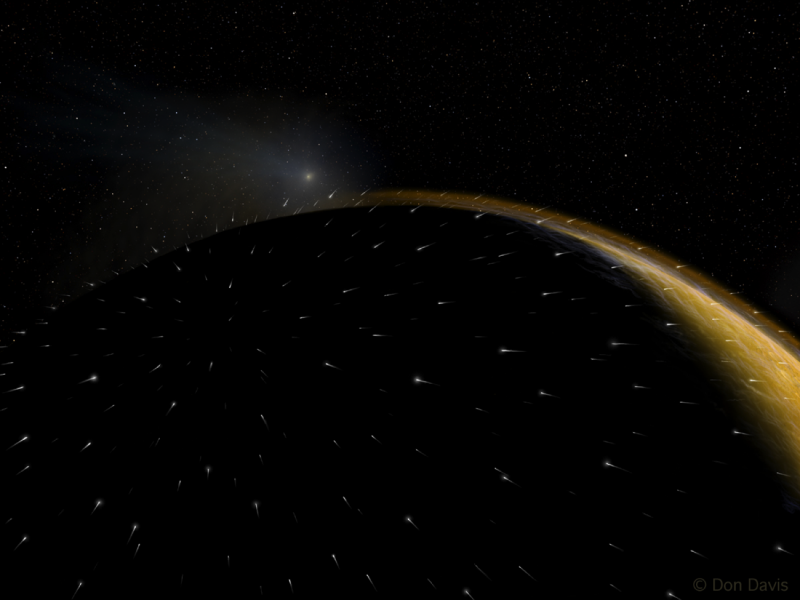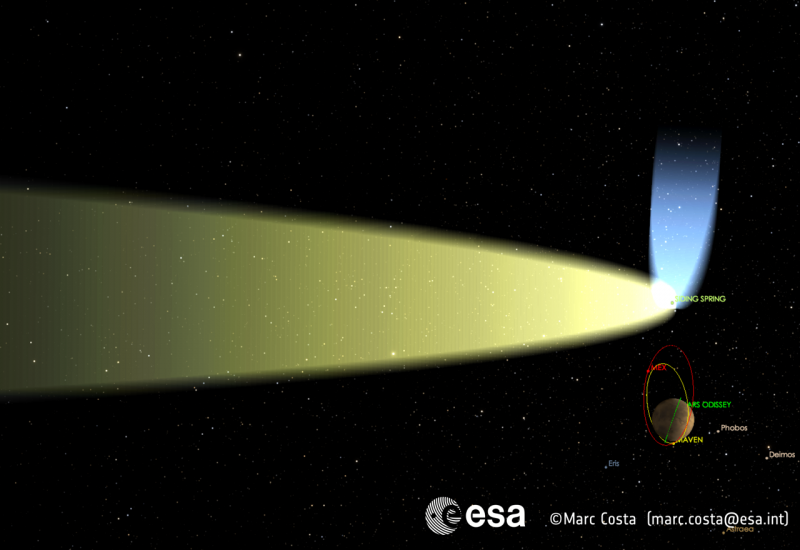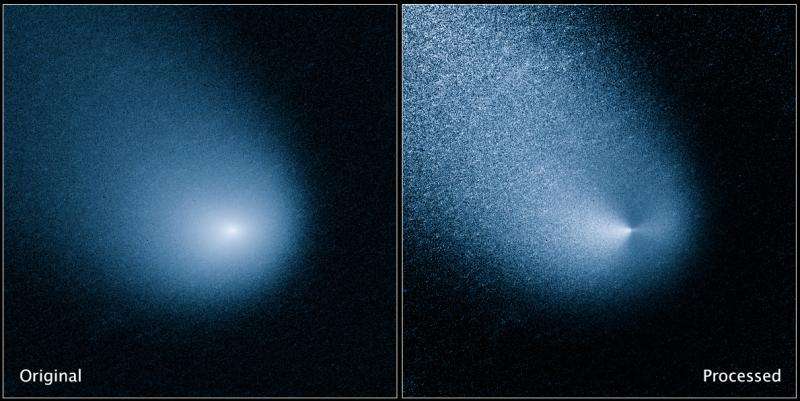Solar eruption 'photobombed' Mars encounter with Comet Siding Spring

When Comet C/2013 A1 (Siding Spring) passed just 140,000 kilometres from Mars on 19th October 2014, depositing a large amount of debris in the martian atmosphere, space agencies coordinated multiple spacecraft to witness the largest meteor shower in recorded history. It was a rare opportunity, as this kind of planetary event occurs only once every 100,000 years. However, scientists analysing the data have found that a very powerful Coronal Mass Ejection (CME) launched by the Sun also arrived at Mars 44 hours before the comet, creating significant disturbances in the martian upper atmosphere and complicating analysis of the data. Results describing the combined effects of the comet and the CME throughout the martian atmosphere are being presented in a special session at the European Planetary Science Congress (EPSC) 2017 in Riga on Thursday, 21st September.
Dr Beatriz Sanchez-Cano, of the University of Leicester and co-organiser of the session, explains: "Comet Siding Spring flew very close to Mars, at one third of the Earth-Moon distance. This is one of the most exciting planetary events that we'll see in our lifetime. Mars was literally engulfed by the coma, the comet's outer atmosphere, for several hours. However, a deeper analysis of the data shows that the comet's interaction with Mars is much more difficult to understand than we expected because of the effects of a CME that hit Mars a few hours earlier. In addition, the encounter happened at the peak of the martian dust season. We need to understand the full context of the observations in order to separate out the real cometary effects on Mars."
CMEs occur when magnetic field lines at the visible surface of the Sun become tangled and break, releasing large quantities of electrically charged particles into space. The interval before, during and after the Comet Siding Spring encounter with Mars was one of the most disturbed periods of the current solar cycle. The CME was launched from the largest sunspot group observed in the last 24 years and several additional solar flares were detected that would have impacted on Mars around this time.

Sanchez-Cano has investigated the interaction of the comet with energetic particles from the Sun, and the effects of the CME and cometary encounter on the martian atmosphere, using data from ESA's Mars Express mission, NASA's MAVEN and Mars Odyssey orbiters, and the Curiosity rover on the martian surface. Her results show clear signs of 'showers' of energetic oxygen ions and dust from the time that Mars was inside the coma up to 35 hours after comet's closest approach. These ions, most likely from the comet, were accelerated by the highly active solar wind during the comet encounter and delivered into the martian atmosphere. This created an extra electrically-conducting layer (ionosphere) at a lower level than the planet's usual ionosphere. None of those particles seem to have arrived at the martian surface as observed by the Curiosity rover, confirming that they were absorbed in the atmosphere.
Prof Mats Holmström, of the Swedish Institute of Space Physics, who will present the first results of the encounter from the Mars Express ASPERA-3 instrument, says: "Our data and modelling show that the upper layers of the martian atmosphere were disturbed by the passing comet. The precipitation from the comet was mainly water, either in the form of neutral molecules or broken down into ions through interactions with light. However, the ASPERA-3 results show that the amount of ionised water interacting with the martian atmosphere was much smaller than expected, compared to the amount of neutral water molecules and the charged particles from the solar wind. This means that there were less of the ions interacting with the upper atmosphere and more water molecules interacting at lower depths. We think that, because of the relatively large size and activity of the comet, the majority of ionised water was carried away by the solar wind rather than dropping down into Mars's atmosphere.

Matteo Crismani, of the University of Colorado at Boulder, will present observations of the encounter from the MAVEN orbiter. These indicate that the meteor shower was the largest in recorded history, peaking at 30 meteors per second and lasting up to 3 hours. Dust grains from the comet, travelling at 200,000 kilometres per hour, entered Mars's atmosphere with enough energy to melt and release their constituent atoms, such as magnesium and iron. Data from MAVEN's Imaging UltraViolet Spectrograph (IUVS) enabled Crismani and colleagues to determine the composition these metallic species, how they evolved and how they moved through the martian atmosphere.
More information: EPSC 2017 Abstract: 'Energetic particle showers over Mars from comet Siding-Spring' B. Sanchez-Cano, O. Witasse, M. Lester, A. Rahmati, S.W.H. Cowley, R. Ambrosi, M. Costa, J. Espley, J. Guo, F. Leblanc, R. Lillis, J.J. Plaut, and R.F. Wimmer-Schweingruber. meetingorganizer.copernicus.or … 017/EPSC2017-113.pdf
EPSC 2017 Abstract: 'Interaction between Mars' induced magnetosphere and the comet Siding Spring (keynote talk)'. M. Holmström, Y. Futaana, and S. Barabash. meetingorganizer.copernicus.or … 017/EPSC2017-410.pdf
EPSC 2017 Abstract: The Metals Delivered by Comet Siding Spring to Mars, M Crismani, N Schnider, S Jain, J Plane, J Deighan, S Evans, R Yelle, J Carrillo-Sanchez, and M Chaffin. meetingorganizer.copernicus.or … 017/EPSC2017-375.pdf
Provided by Europlanet Media Centre





















